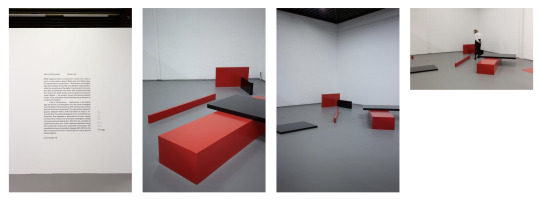#Onomatopee
Text
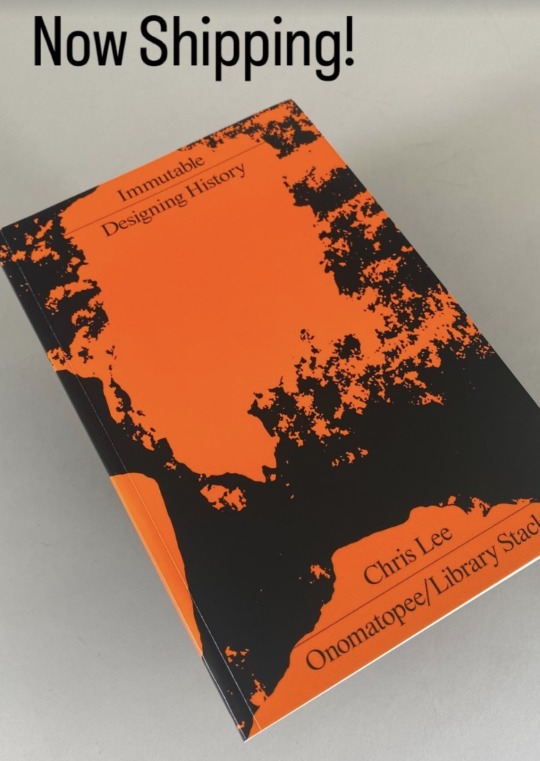
After a very long wait, copies have arrived from Europe!
Immutable: Designing History by Chris Lee
Available at Draw Down Books
Immutable: Designing History explores the banal genre of the document and its entanglement with statecraft and colonial(ism/ity). This is framed as a ~5,000 year chronology, imbricating the developments of money and writing—from Mesopotamian clay tablets to distributed ledgers, like the blockchain.
Immutability figures as a design imperative and hermeneutic for considering a variety of techniques (material, technological, administrative, etc.) of securitization against the entropy of a document’s movement through space/time, and the political.
This project is driven by a contrast: design educators tend to teach forms like logos, books, websites, etc., but not passports, money, property deeds, etc., in spite of these being design’s most profoundly consequential forms.
As an alternative historiography, Immutable gestures both towards anthropologist Laura Nader’s call to “study up” (on those in power), and the radical educator Paolo Freire’s recognition of the “limit situation” as a generative condition for emancipatory praxis. The volume’s aim is to orient graphic design towards the vocation of imagining, naming, and remembering beyond the horizons of its role as a managerial, administrative, and colonial instrument that imposes a rationality of vision and accountability upon what is knowable, thinkable and sayable.
Designed by Chris Lee
Published by Onomatopee and Library Stack, 2023
Softcover, 192 pages, 50 duotone images, 5 × 7.75 inches
ISBN: 978-9-49-314842-0
#Chris Lee#Immutable: Designing History#Design Books#Design History#Graphic Design Books#Design Theory#Onomatopee#Library Stack
12 notes
·
View notes
Photo



YAY!!!
Just finished these amazing rugs!
And they are now available in my brand-new Etsy shop ^^
https://www.etsy.com/nl/shop/TheHedgehogManiac
#sonic#sonic the hedgehog#sega#sonic fan art#fan art#tails#tails the fox#miles prower#tails miles prower#rug#carpet#tuften#tufting#comic#comic book#pow#onomatopee
7 notes
·
View notes
Text
can’t stop biting
2 notes
·
View notes
Photo

Meuh ! . . #vache #vaches #cow #cows #vachesuisse #cowstagram #sapi #sapiswiss #rumput #padangrumput #pemandangan #pemandanganalam #pemandanganswiss #onomatopee #onomatopée #sapimakanrumput #sapisusu #suisse #swiss #switzerland #lifeisgood😎 https://www.instagram.com/p/CgNIXiKIEWv/?igshid=NGJjMDIxMWI=
#vache#vaches#cow#cows#vachesuisse#cowstagram#sapi#sapiswiss#rumput#padangrumput#pemandangan#pemandanganalam#pemandanganswiss#onomatopee#onomatopée#sapimakanrumput#sapisusu#suisse#swiss#switzerland#lifeisgood😎
0 notes
Text
Toccata con lo scherzo del cucco
Toccata con lo scherzo del cucco
Bernardo Pasquini (1637 - 21 novembre 1710): Toccata con lo scherzo del cucco. Lorenzo Ghielmi all’organo Rieger del Duomo di Essen (Renania Settentrionale-Vestfalia).
youtube
View On WordPress
7 notes
·
View notes
Note
re: your poetry post, can you give some pointers as to where to learn the rhyming patterns in poetry and the like? i only ever see poetry from the ideas/feelings perspective, but ive never learned the logic and structure behind it lol
I've learned most of it from my literature and grammar classes, it's taught in our school since elementary, so I wouldn't know of any books or manuals that talk specifially about it - but I can give you a rundown of how I do it, anon, if it counts for anything lol
Prefacing that this will be starting from italian poetica because that's what I know best: any poem, but specifically the pre-futurism/1910s ones (A Lot) will have some kind of structure aside from just the ryming scheme;
The structure I am most familiar with is accentual-sillabic, so for example any single verso will have its stressed syllable in a fixed potision and occasionally a set number of sillables (eg. an endecasillablic metre means a stress on the tenth syllable, usually penultimate, equally to 11 total syllables), but there are also only accentual, or only sillabic verses, common in French poetry (?), all of which count as types of qualitative metre - as well as quantitative metre, which was more widley used in Latin and Greek poetry and which rather based itself on patterns of syllable weight (something that I know little about tbh; I think it's based on the lenght of pronunciation of the actual syllable).
this, of course, goes without even mentioning free-verse structure and less well-known ones.
Going back to the rhyming scheme, that also comes into play with structure in the sense that ... there are just a lot of them to pick from. The classic is the repeated AABB one, where each verse will rhyme with the one underneath (''kissing rhyme'' in italian), or the alterning ABAB, the crossed ABBA, the 'chained' or third rhyme ABA BCB CDC used for terzine, and plenty more!
That's not all the ways to classify rhymes of course: you have plain rhyme between words accented on the penultimate syllable, cut rhyme between words accented on the last, sdrucciola with accents on the third-to-last, bisdrucciola on the fourth-to-last... etc etc
Then, of course, come the classifications in stanza lenghts! Groups of three verses are a terzina, well known for being Dante's favourite number (joke inserted to lighten this infodump), groups of four a quatrina, etc -
and depending on the number of single groups and on the type of verses in them, you have further classification as canzone, ode, madrigale, carme, filastrocca, ballata, sonetto... the latter for example is made of fourteen endecasyllabic verses grouped in two quartine, one in the beginning and one in the end, in crossed or alternate rhyme, and two terzine with any kind of rhyme structre.
this of course doesn't touch on the inner things and games of poem structure like the falling rhyme, spaces in between groups, enjambement, alliteration, allegorical figures, anafore, onomatopee, and all that fun stuff!
Essentially when you see a poem look for the number of syllables in each verse, where the stressed syllable falls, how the rhymes are put, how many verses are in each stanza and strofa...
#et cetera et cetera#poetry#DISCLAIMER HI. I AM NOT AN EXPERT THIS IS JUST STUFF I USE TO READ POETRY FOR FUN.#[.asks]#anonymous#it's so sad for me that people only talk about the feelings side of poetry as an art form because! What about the structure! The words!#methinks this is why I don't like a lot of modern poetry#It lacks the acknowledgement of ALL this work that goes behind making good verses!#and ofc free verse is a thing but I will be problematic here and say I don't like free verse or free-rhyme. I'm a hater
17 notes
·
View notes
Text
il mio cuore sembra filippo tommaso marinetti quando ha scoperto le onomatopee
6 notes
·
View notes
Text
ora buongiorno assesta un pugno sul naso a questo olandesaccio e gli cambia i connotati, spuntano le onomatopee con scritto PAM! e OUCH! tipo fumetti tutt’intorno
5 notes
·
View notes
Photo
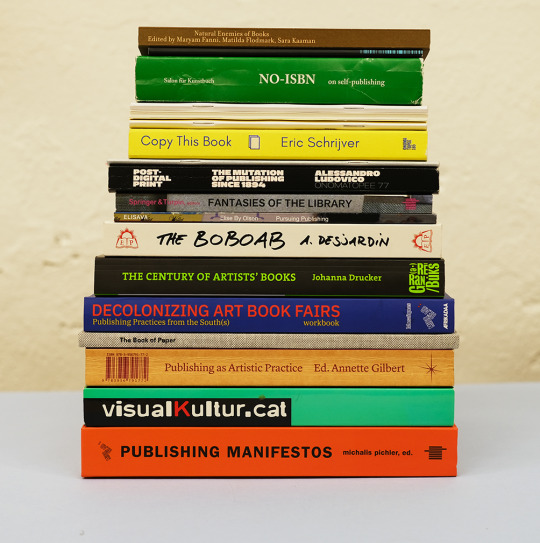



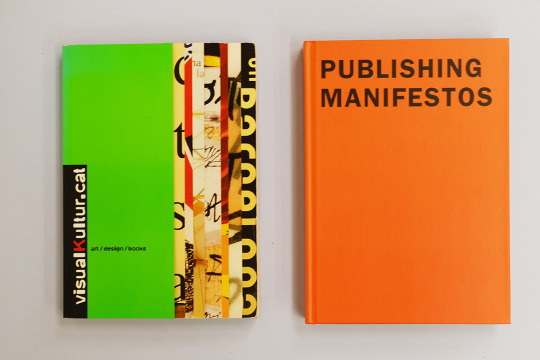
Publishing as Artistic Practice //
Some reads on the subject // Somewhere to get started // From top to bottom:
Books on publishing
Natural Enemies of Books // Edit. Maryam Fanni, Matilda Flodmark, Sara Kaaman // Funded by the Swedish Arts Grants Committee and through an artist-in-residence period at Grafikens Hus, in collaboration with the Södertälje Konstnärskrets.
Book to the future // Simon Worthington // Open Mute
NO-ISBN on self-publishing // Sylvie Boulanger, Ulises Carrión Edit. Bernhard Cella, Leo Findeisen, Agnes Blaha // Salon für Kunstbuch
Don’t rest, narrate // Rachel Withers, Nicholas John Jones // PRAKSIS, Fritt ord
Copy this book // Eric Schrijver // Onomatopee
What problems can Artist Publishers solve? // Temporary services / Printroom
Post-digital print – The mutation of publishing since 1894 // Alessandro Ludovic // Onomatopee
Fantasies of the library // Edit Anna-Sophie Springer, Etienne Turpin // The MIT Press
Pursuing Publishing // Elise By Olsen // Elisava
The BOBOAB (The Book on Books about Artists books) // Arnaud Desjardin // The Everyday Press,
The century of artists’ books // Johanna Drucker // Granary books
Decolonizing art book fairs – Publishing practices from the South(s) // Edit Yaiza Camps, Moritz Grünke, Pascale Obolo, Michalis Pichler, Parfait Tabapsi // Miss Read, Afrikadaa and Mosaïques
The book of paper // Oliver Helfrich, Antje Peters // Post editions
Publishing as artistic practice // Edit Annette Gilbert // Sternberg press
VisualKultur.cat // Edit Daniel Giralt-Miracle, Vicenc Altaio // ActarD Inc
Publishing manifestos // Edit Michalis Pichler // the MIT press
7 notes
·
View notes
Text
Titolo: Una storia non storia
Oggi propongo un testo che dovrebbe parlare di qualcosa, ma non lo fa, privo di alcun tema, carattere o significato.
Avrei potuto mettere un inizio ad effetto, una citazione o anche solo un semplice “Ciao”, avrei potuto stilare una sinossi, introdurre un concetto o – sai – semplicemente raccontare una storia.
Non voglio raccontare assolutamente nulla: né di nuovo, né di vecchio.
Cosa ci faccio qui, allora, a scrivere parole vuote su parole vuote, premendo su una tastiera disperata con delle dita prive di inventività? Che cosa contraddistingue questo brodo sintatticamente organizzato da un banale sproloquio di uno scrittore frustrato?
Questa è una domanda che, in virtù del tipo di testo che voglio produrre, non riceverà una risposta.
La prossima riga, per quanto ne so, può essere semplicemente occupata da delle onomatopee: sì, facciamo così!
lalalalalalalalalalalalalalalalalalalalalalalalalalalalalalalalalalalalalalalalalalalala.
Vedete questo? Possiamo davvero mettere nero su bianco ogni nostra fervida dissennatezza, potremo lasciarci cullare dalla mestizia delle parole, perfino le più effimere e flebili raccontano una storia e legandosi ad altre parole non fanno altro che formare cronache sempre più articolate!
Perché iniziare una storia, di fantasia o meno, quando posso semplicemente ripetere alternatamente onomatopee, sillabe o addirittura lettere in successione casuale?
Perché devono essere le parole a raccontare, quando potrebbero prendersi una pausa e lasciare il loro compito all’inchiostro, o alla carta?
Perché devo sforzarmi a scrivere e perché le parole si devono sforzare? Che si riposino, per Dio!
La sto tirando per le lunghe, non è così?
Lo scherzo è bello finché dura poco, dov’è la mia storia? Ti chiederai.
Ma che cosa chiedi, la penna la tengo dalla parte del tappo, sarò io a decidere cosa merita di stare ai tuoi occhi.
Uno scrittore, sin dall’inizio della prima stesura, stabilisce un patto con il lettore: qualità e intrattenimento per incitamento e creatività; filtriamo, organizziamo e decidiamo cosa sarà alla tua vista, si può dire che in questo momento io sia in tutt’uno con i tuoi occhi.
Se li tieni aperti, vivo, mentre se li chiudi, come artista posso definirmi defunto.
Per favore, guardami, guardami, guardami! Guarda quanto sono originale, guarda quanto sono creativo!
Guardami, osservami, studiami.
Sarò pure ciò che ti permette di veder questo, ma tu sei ciò che mi tiene vivo.
In fondo, può darsi che in questo cumulo di immondizia metafisica qualcosa sia emerso, quanto possiamo spingerci per l’approvazione di qualcuno?
Perché sto continuando a scrivere tutto questo?
Perché le mie dita prive di inventività continuano a danzare tra i miei tasti, ormai frusti e logori?
Troppi perché, questo posso dire, troppi perché.
Questo forbito ma pleonastico elaborato merita ancora vita?
Io non voglio che quegli occhi si chiudano, tuttavia non sto facendo intrattenimento, sto solo proliferando disperazione.
Basta, basta, basta!
Fermate tutto questo, non mi sta piacendo.
Chissà se cambiando lo stile estetico può uscirne fuori qualcosa di diverso, proviamo.
. . .
C’era una volta… In una terra lontana lontana, uno scrittore che non sapeva scrivere racconti…
. . .
Scrivendo una storia andrei contro tutto ciò in cui credo, e forse lo sto già facendo: forse una storia la sto già scrivendo, e se per questo, una storia piuttosto noiosa.
Non sarà stato il tentativo migliore, ma il primo tentativo non è conosciuto come il migliore.
Mi permetto il lustro di cambiare stile narrativo per queste ultime righe:
L’ultima cosa che X si sarebbe aspettato in quel frangente di tempo sarebbe stato sentire qualcosa di diverso dalle sue onomatopee immaginarie e dai suoi fremiti incessanti. Qualcuno aveva bussato alla sua porta, potesse essere il suo ospite?
Tempo di una storia che sia una storia.
5 notes
·
View notes
Text

A Cookbook of Invisible Writing, by Dutch artist, designer, and teacher Amy Suo Wu, is an introduction to analog steganography—a type of secret writing that is hidden in plain sight.
An invisible ink coloring book, recipe book, puzzle book, and artistic research book, A Cookbook of Invisible Writing also serves as a starter pack to run workshops for those who are interested in alternative forms of communication.
The cookbook provides a wide variety of invisible ink recipes and other communication techniques that may be used to subvert surveillance, bypass censorship, and make visible the struggles of minorities and other marginalized cultures. Additionally, this book aims to inspire communities to develop their own poetic and playful forms of communication as a way of nurturing social bonds.
In the tradition of esoteric manuals published on secret writing, ACIW also channels the spirit of everyday access and the easy distribution and sharing of practical knowledge. Following Giambattista della Porta’s 1558 popular science book Natural Magic—one of the first major publications that detailed simple but diverse recipes of invisible inks for public consumption—this cookbook aims to bring this obscure field to a wider audience.
Includes a critical essay about the history of surveillance through a feminist and postcolonial lens, along with a final chapter that presents Wu’s own body of work, showcasing her ambition to revive analog techniques as a counter to today’s digitally-surveilled mediascape.
Written, designed and illustrated by Amy Suo Wu
Edited by Clementine Edwards
Published by Onomatopee, 2019
Softcover, spiral binding with flaps, 224 pages, color and b&w images, 6.75 × 9.5 inches
instagram
#Amy Wu#A Cookbook of Invisible Writing#Onomatopee#invisible writing#design as camoflauge#surveillance and graphic design#Draw Down Books#Instagram
5 notes
·
View notes
Link
Where does this focus on floppy disks come from? Why not work with another medium?
In the beginning, I figured we would do floppy disks, but never CDs. Eventually, we got into CDs and I said we’d never do DVDs. A couple of years went by and I started duplicating DVDs. Now I’m also duplicating USB drives. You can see from this conversation that I’m not exactly a person with great vision. I just follow what our customers want us to do. When people ask me: “Why are you into floppy disks today?” the answer is: “Because I forgot to get out of the business.”
A look behind the scenes at the floppy disk industry, and the economics of legacy computing.
3 notes
·
View notes
Photo

🐮 Meuh ! . . #moo #meuh #meuhvache #moocow #vache #cow #sapi #mural #lukisandinding #grafiti #tunnel #onomatopee #onomatopée #kepalasapi #kurban #iduladha #sousterre #gare #chateudoex #switzerland #swiss #suisse #lifeisgood😎 (à Château-d'Oex, Switzerland) https://www.instagram.com/p/CfUrJ41oFRY/?igshid=NGJjMDIxMWI=
#moo#meuh#meuhvache#moocow#vache#cow#sapi#mural#lukisandinding#grafiti#tunnel#onomatopee#onomatopée#kepalasapi#kurban#iduladha#sousterre#gare#chateudoex#switzerland#swiss#suisse#lifeisgood😎
0 notes
Text

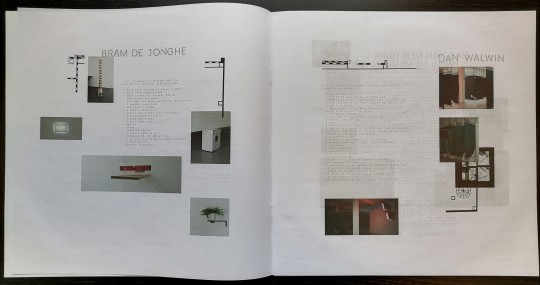





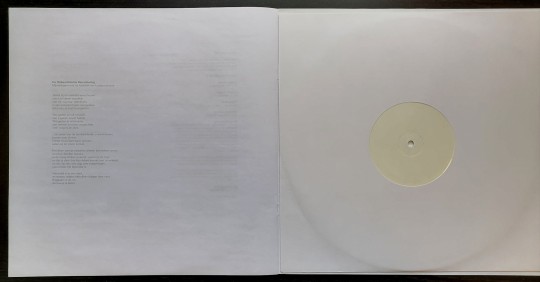

Freek LOMME
"The unmediated Mediation / De onbemiddelde Bemiddeling"
(LP. Onomatopee. 2016) [NL]
0 notes
Text
Divertimento in cui si esprime una uccellaja
Alessandro Speranza (24 aprile 1724 - 1797): Divertimento per cembalo in cui si esprime una uccellaja in sol maggiore. Falerno Ducande alias Fernando De Luca.
youtube
View On WordPress
0 notes
